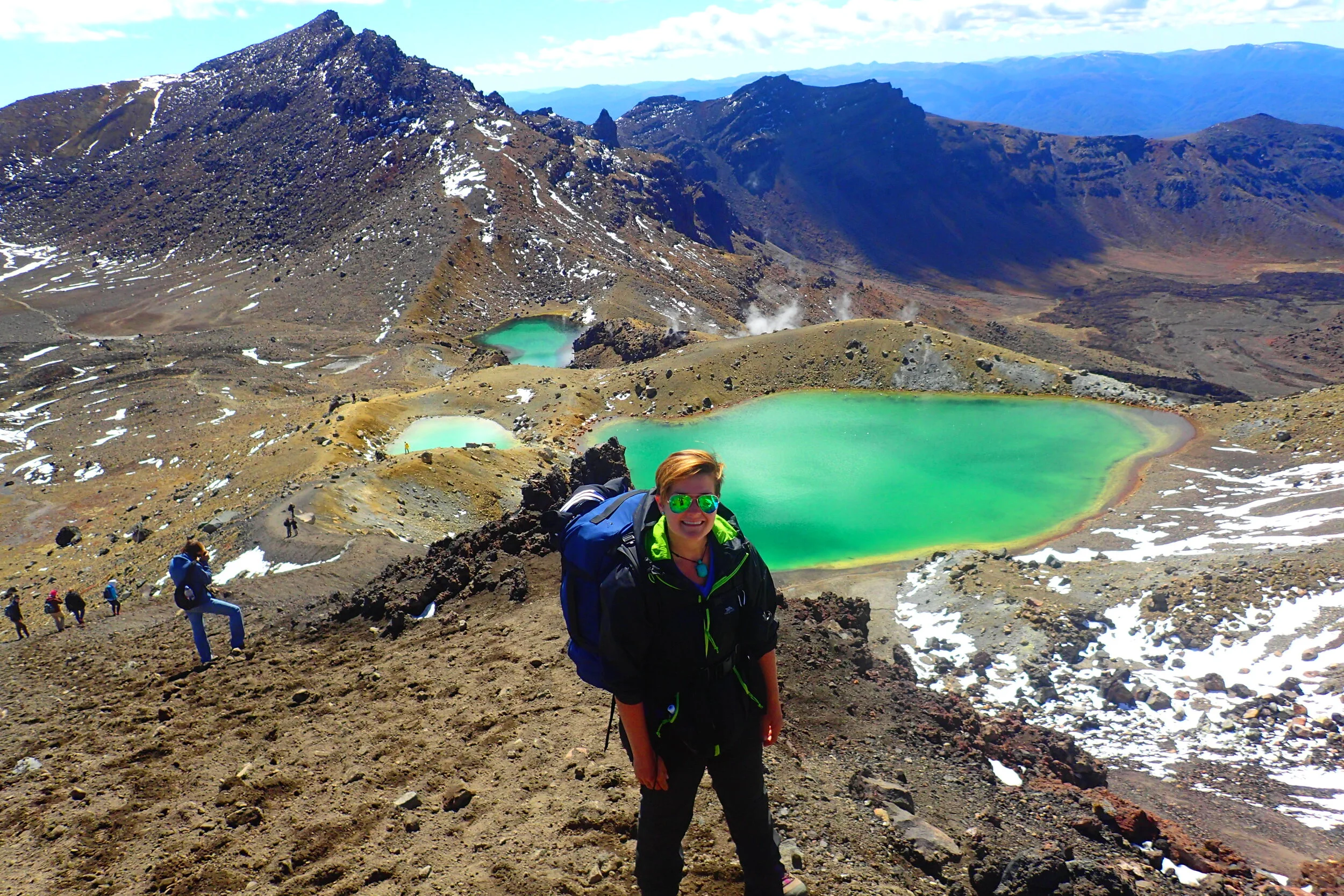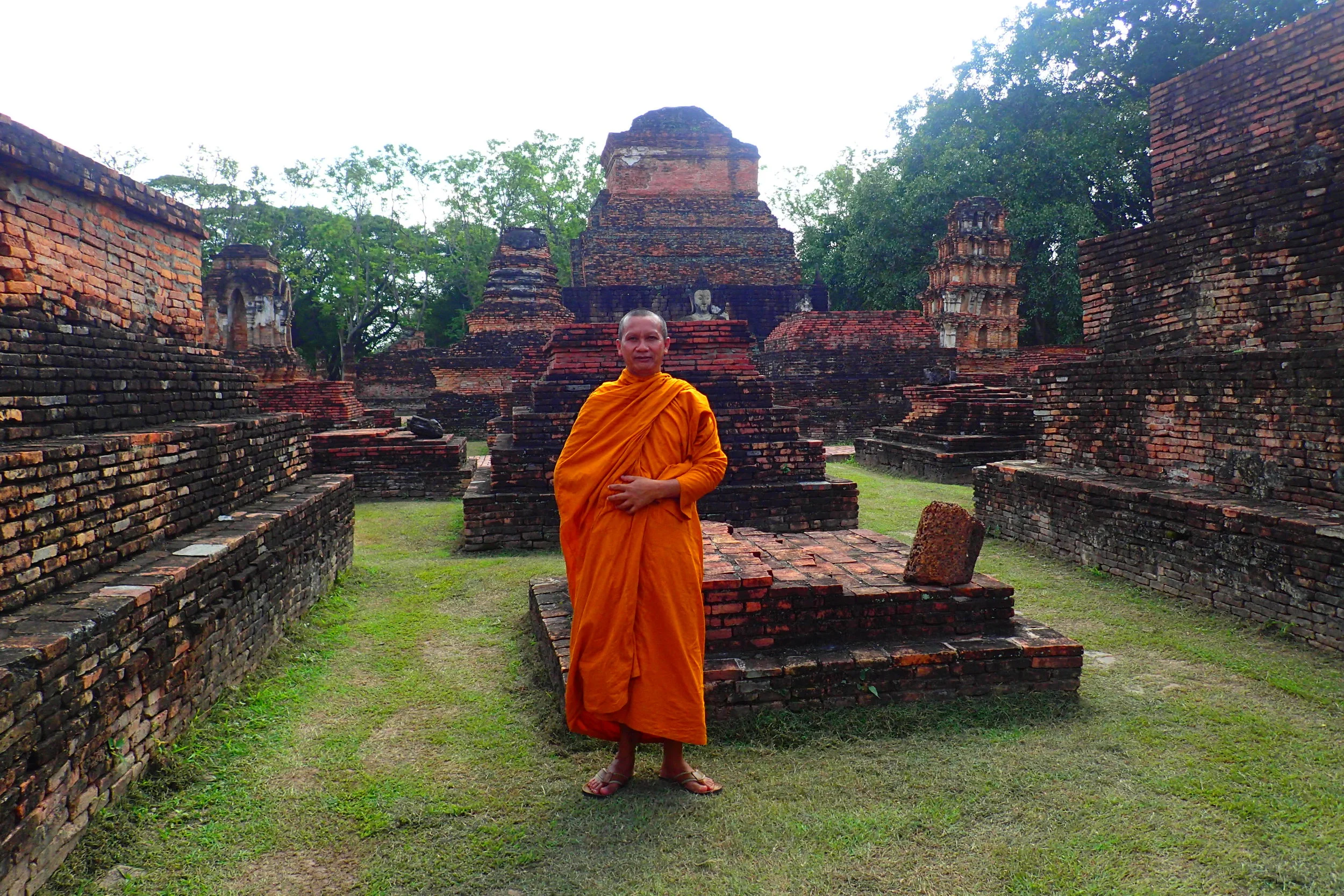When I visit a country, I like to open myself up to the culture through its food. If the food is served at a place locals frequent rather than a tourist trap or if the food is ordered for me by a local, I know I’m getting an authentic experience.
In past posts about my eating experiences in Portland, Iceland and Germany, I was able to name what I ate or at least describe what I ate fairly easily. The numerous, unfamiliar ingredients used in Thai cooking, the complexity of the Thai names for dishes, and the poor English translations usually meant I had no idea what I was eating half the time.
Near the end of my time in Thailand, I booked a $7 bus one-way from Chiang Mai to the city of Sukhothai. Sukhothai was the capital of Siam Kingdom in the 13th and 14th centuries. Buddhism boomed there at that time resulting in the construction of many monasteries and other structures. Today, the ruins of the old kingdom are a UNESCO World Heritage site. The area is expansive and has well-maintained roads and pathways throughout making it best viewed by bicycle! I had the chance to spend a whole day there just before leaving Thailand.
I loved spending time in Chiang Mai. I even went back and spent two more nights there after living in Pai for a week. Available all over the city are opportunities to go on jungle treks and hill-tribe tours in the surrounding Northern mountains. But I did not need to do any of these to fill my time. I had already spent over a week in Chiang Mai, during which time I met a monk at Wat Chedi Luang, drove a motorbike up Doi Suthep, released a lantern into the sky at the Yi Peng festival, and celebrated Halloween as a Walking Dead zombie. If these activities weren’t already enough, here are three more experiences in Chiang Mai I enjoyed.
When I decided to go to Pai, I only meant to spend up to 3 days there—but I ended up spending 7 nights! The main reason I ended up staying so long was Jimmy. Jimmy is a 25 year old, Rastafarian Thai man from the southern islands. I met him on the night of the Festival of Lights in Chiang Mai and randomly bumped into him in Pai on my first night there.
Jimmy took me all over Pai on his motorbike and introduced me to his friends at Sunset bar. They all became like family to me. I had a great time with them…well, except when I tried a little snack they were eating one evening!
Throughout my first two weeks in Thailand, I kept hearing people tell me about a place called Pai (pronounced pie). “Have you been to Pai yet?” “Are you going to Pai?” “Oh, you have to go to Pai!” I learned it’s a small, hippie town with a feeling not unlike the Thai islands. The only difference is it’s located in the Northern mountains surrounded by rice farms. I’m not always one to do what everyone else is doing, but I loved the life on Ko Tao so much I was craving more of the island feel.
I booked a van for the equivalent of $4.50 along the insanely windy 3 hour route between Chiang Mai and Pai. I had no plans once I got there. I figured I’d spend 2 or 3 days just to feel the place out. I'd find out what to do and where to go after I arrived. Being completely open to seeing and doing anything, I ended up staying 7 nights and having an awesome time! In fact, I want to go back. So this is my list of reasons to visit Pai, or go again!.
“I can’t believe I almost missed this,” I said aloud to my new friends as we walked down the sidewalk toward the Ping River. Above us, thousands of golden, twinkling lanterns were floating up and taking to the winds across the night sky, morphing and expanding along the thermals like a galaxy of stars. Just a few days earlier, I had made the decision to skip out on what would have been a much-too-short motorbike trip around the Mae Hong Son loop.
Instead, I met a Thai local named Samart who graciously hosted me for the week. I had the awesome opportunity to meet many of his friends, employees, and volunteers—a mixture of Thai locals and other travelers—who work with him at his bungalows outside Chiang Mai. Several of them had come into the city just for the Yi Peng and Loy Krathong festivals.
During these last 3+ months of travel, I have found the solo travel lifestyle to be a perfect way to deviate freely and openly. Without surprise, I have spent very little time traveling alone. Even traveling between locations, like my overnight train from Bangkok to Chiang Mai, I have rarely been by myself or kept to myself. I meet couples, other solo travelers, old friends from back home, and locals. I strike up conversations, exchange contact info, and sometimes I even temporarily combine travel plans. But not being tied down to people in a permanent way has led me down alternative paths to other exciting adventures.
In this post I am going to highlight one of the best parts about solo travel through a moment when I was in Thailand and my plans with another traveler went awry. Why would being a solo traveler be a good thing in this case? Read on to find out.
I was going to call this post “Monks and Motorbikes” but then I realized you would all picture monks riding motorbikes around and that would have been completely inaccurate. My in-depth post about my interactions with monks will have to come later. Instead, this post is about the day I got over my fear of riding a motorbike which included a ride up to a Buddhist temple near Chiang Mai.
West of Chiang Mai is Doi Suthep-Pui National Park. Just before the Doi Suthep mountain summit (1676m) is the temple Wat Phra That Doi Suthep—a famous Buddhist pilgrimage site. Other travelers staying at the Julie Guesthouse suggested going there as a fun day trip. They mentioned songthaews and buses as the means to get up there. “Or you could just rent a motorbike,” said one traveler.
Many of my friends and family back home are aware of my affinity for costumes and cosplay. Naturally, one of my favorite times of the year is Halloween—where you can dress up as anything you want, party until dawn, and eat lots of candy. What’s not to love?
When I realized I would be in Thailand for Halloween, missing out on all the fun parties back in New York, I was determined to find a costume to wear and party to attend. Halloween is not typical to Thai culture, so I was expecting to have to deviate the norm a bit to find a suitable costume and party. To my delight, I ended up receiving a zombie makeover, attracting the attention of many Thai locals with my undeadness, and partying with Thai people and other backpackers until the wee hours of the morning. A Halloween worthy of my high standards.
There was an excitement in the air each morning at the Big Bubble resort just after the sun had broke over the bay’s southern hills. Five of us divers would scramble to gather equipment and load it onto the small boat to carry out to the big boat where a large group of people would meet us from a neighboring resort. We’d travel out to our location, anchor up to the mooring, then jump in and descend.
After 3 days of these diving adventures, it was time to do something different. But I was not ready to leave the island yet. I ended up staying for an extra two nights. During this time, I got to experience more of the island life, connect with the local Thai people, swim and snorkel at the beaches, and celebrate a new friend’s birthday.
When I left Bangkok for Ko Tao, I had no idea what I was going to decide to do once I arrived at the dive resort where Astrid works. I have always wanted to take a SCUBA diving course and get certified, but I never thought I’d do it in Thailand. Between the excellent instruction I received, the great underwater visibility, and the diverse tropical fish and coral reef, I made the best decision to learn to dive off the shores of Ko Tao.
After the 9 hour bus and ferry ride from Bangkok, one of the Big Bubble resort taxi drivers picked me up from the port. Five minutes later, we arrived at the resort where I met KaiNui who is one of the master divers at Big Bubble. He introduced me to a list of dive options and their prices. The open water diver certification course involved watching a video, receiving short instruction in the classroom, and going on 4 dives, 2 the first day which were mainly training focused and 2 the following day which were for fun and practice. The course cost about $300 USD and included 4 nights’ accommodation in their bungalows. Normally there are up to 6 other divers in each training group, but because it was low season for tourists on the island, I ended up having a private instruction for the group price! You cannot get this kind of deal back home, so I was immediately in.
Before coming to Thailand, I had done an exorbitant amount of research on what to expect, what to avoid, and what to absolutely see and do. But as a rule in life, and also when I travel, I try not to have hard and fast expectations about things—I like to let my first-hand experience influence my impression and direct my path. This is how I create my own personal norm, tailored to me.
Pretty much every person and blog said something along the lines of “avoid the tourist trap of Khao San Road” or “go to Khao San Road just to experience it, but don’t stay there.” I decided to go against this advice completely by, instead, booking my first night of accommodation in the center of it all. I had researched some good, reasonably priced hotels in Bangkok and the one which stuck out to me was called the Rikka Inn. It was calling my name—literally!—and so I didn’t care about its location or its higher-than-usual price compared to the guesthouses in the area. I just knew I’d need a good night of sleep after the 11-hour flight from Munich.













